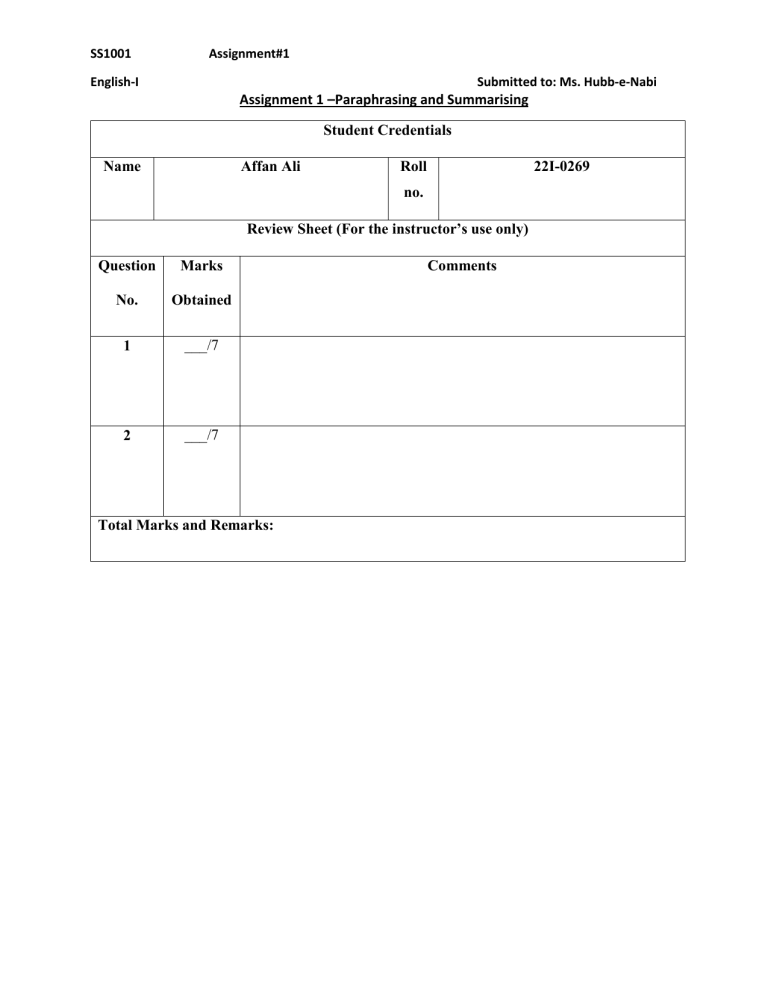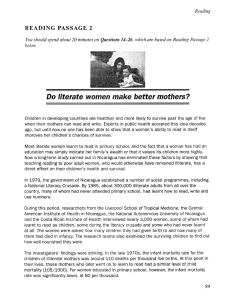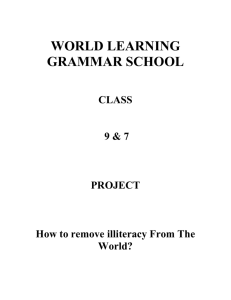
SS1001 Assignment#1 English-I Submitted to: Ms. Hubb-e-Nabi Assignment 1 –Paraphrasing and Summarising Student Credentials Name Affan Ali Roll 22I-0269 no. Review Sheet (For the instructor’s use only) Question Marks No. Obtained 1 ___/7 2 ___/7 Total Marks and Remarks: Comments SS1001 Assignment#1 English-I Submitted to: Ms. Hubb-e-Nabi Before reading the following material, you should read the questions given below and understand your purpose for reading. Literate women make better mothers? Children in developing countries are healthier and more likely to survive past the age of five when their mothers can read and write. Experts in public health accepted this idea decades ago, but until now no one has been able to show that a woman's ability to read in itself improves her children's chances of survival. Most literate women learnt to read in primary school, and the fact that a woman has had an education may simply indicate her family's wealth or that it values its children more highly. Now a long-term study carried out in Nicaragua has eliminated these factors by showing that teaching reading to poor adult women, who would otherwise have remained illiterate, has a direct effect on their children's health and survival. In 1979, the government of Nicaragua established a number of social programmes, including a National Literacy Crusade. By 1985, about 300,000 illiterate adults from all over the country, many of whom had never attended primary school, had learnt how to read, write and use numbers. During this period, researchers from the Liverpool School of Tropical Medicine, the Central American Institute of Health in Nicaragua, the National Autonomous University of Nicaragua and the Costa Rican Institute of Health interviewed nearly 3,000 women, some of whom had learnt to read as children, some during the literacy crusade and some who had never learnt at all. The women were asked how many children they had given birth to and how many of them had died in infancy. The research teams also examined the surviving children to find out how well-nourished they were. The investigators' findings were striking. In the late 1970s, the infant mortality rate for the children of illiterate mothers was around 110 deaths per thousand live births. At this point in their lives, Those mothers who later went on to learn to read had a similar level of child mortality(105/1000).For women educated in primary school, however, the infant mortality rate was significantly lower, at 80 per thousand. In 1985, after the National Literacy Crusade had ended, the infant mortality figures for those who remained illiterate and for those educated in primary school; remained more or less unchanged. For those women who learnt to read through the campaign, the infant mortality rate was 84 per thousand, an impressive 21 points lower than for those women who were still illiterate. The children of the newly-literate mothers were also better nourished than those of women who could not read. Why are the children of literate mothers better off? According to Peter Sandiford of the Liverpool School of Tropical Medicine, no one knows for certain. Child health was not on the curriculum during the women's lessons, so he and his colleagues are looking at other factors. They are working with the same group of 3,000 women, to try to find out whether reading mothers make better use of hospitals and clinics, opt for smaller families, exert more control at home, learn modem SS1001 Assignment#1 English-I Submitted to: Ms. Hubb-e-Nabi childcare techniques more quickly, or whether they merely have more respect for themselves and their children. The Nicaraguan study may have important implications for governments and aid agencies that need to know where to direct their resources. Sandiford says that there is increasing evidence that female education, at any age, is 'an important health intervention in its own right' .The results of the study lend support to the World Bank's recommendation that education budgets in developing countries should be increased, not just to help their economies, but also to improve child health. 'We've known for a long time that maternal education is important,' says John Cleland of the London School of Hygiene and Tropical Medicine. 'But we thought that even if we started educating girls today, we'd have to wait a generation for the pay-off. The Nicaraguan study suggests we may be able to bypass that.' Cleland warns that the Nicaraguan crusade was special in many ways, and similar campaigns elsewhere might not work as well. It is notoriously difficult to teach adults skills that do not have an immediate impact on their everyday lives, and many literacy campaigns in other countries have been much less successful. 'The crusade was part of a larger effort to bring a better life to the people,' says Cleland. Replicating these conditions in other countries will be a major challenge for development workers. Q1. Complete the summary using the list of words, A-I, below. Literacy Care D. Mortality B. International research E. Maternal Literacy G. Paternal literacy C. Medical F. Adults and children H. A national literacy crusade I. Family wealth Higher literacy of mothers leads to better growth of their children, but to what extend is this statement true? Sometimes higher literacy only reflects the family wealth of the person, but international study and the National Literacy Crusade carried out in Nicargua showed that teaching reading to poor adult women does in fact has an impact on the health and wellbeing of their children as compared to if those women had remained illiterate. Further study showed that the infant mortality rate for children of illiterate mothers was around 110 deaths per 1000 thousand births whereas for children of women educated in primary school the rate was much SS1001 English-I Assignment#1 Submitted to: Ms. Hubb-e-Nabi lower at 80 at thousand births. This shows the importance of maternal and paternal literacy in the lives of their children. It is possible that literate mothers are able to take better medical care of their children. According to Clealand, maternal education is important is important but it takes a generation for the work to pay off. Clealand also claimed that the Nicarguan crusade was special in many ways and such a campaign might have been less effective in other countries. SS1001 English-I Assignment#1 Submitted to: Ms. Hubb-e-Nabi Q2. Paraphrase the text above. Also provide the key ideas with details. SS1001 Assignment#1 English-I Submitted to: Ms. Hubb-e-Nabi Key Ideas Details Mother’s literacy improves Children in developing countries with literate mothers have a child’s chances of survival higher chance of surviving as they are healthier Teaching to illiterate women Study carried out in Nicaragua shows that teaching reading to can have a direct effect on poor adult women, who would’ve otherwise remained illiterate, child’s health can have direct effect on child’s survival and health Difference in infant Figures for infant mortality rate of children with literate mothers mortality rate between was 21 figures less than that of illiterate mothers, which is a literate and illiterate women significant difference is substantial The exact reason as to why Peter Sandiford and his colleagues looked at other factors to find children of literate mothers out why children of educated women were better off as child are better off is unknown health was not on the curriculum. Replicating the international It is notably difficult to teach adult skills that do not have an literary crusade is a huge immediate impact on their daily lives. Also, many campaigns in challenge others countries have been less successful as compared to Nicaragua. Hence replicating the international literacy crusade will be a huge challenge to overcome. SS1001 Assignment#1 English-I Submitted to: Ms. Hubb-e-Nabi Paraphrase When mothers are literate and can read and write, children in developing countries have a greater chance of surviving past the age of five. Long before anyone could demonstrate that a women’s ability to read increases her child’s chances of survival, public health experts accepted this theory. Majority of women who are literate learned to read in elementary school, thus this might just be a sign of their family’s wealth/income. Through the National Literary Crusade, about 300,000 adult illiterates from all over the country, many of whom had never received any education, had acquired literacy skills. Nearly 3000 women were chosen to figure out the difference between the mortality rates of children who had literate and illiterate mothers, and the results were astonishing. There were approximately 110 deaths per 1000 births for illiterate women and about 84 deaths per 1000 births for literate women. This is a substantial difference and proves that children with literate mothers are better off. For government and humanitarian organisations who need to know where to allocate their resources, the Nicaraguan study may SS1001 English-I Assignment#1 Submitted to: Ms. Hubb-e-Nabi have significant implications. According to Sandiford, there is huge evidence that regardless of age, is a significant health intervention in and of itself. The study findings corroborate the World Bank’s proposal that education budgets in poor nations be boosted in order to improve both child health and their economies. The importance of maternal education has been long recognized, according to John Cleland, maternal education is important is important but it takes a generation for the work to pay off, even if we start now. Cleland also emphasizes that the Nicaraguan crusade was unique and special in several ways and that other such activities were less effective in others countries, hence replicating the International Literacy Crusade is not an easy job. SS1001 English-I Assignment#1 Submitted to: Ms. Hubb-e-Nabi






